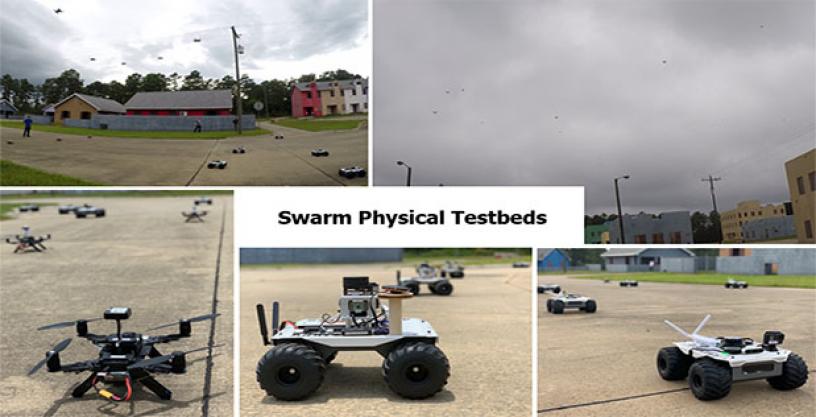
OFFSET program solicits proposals for fifth swarm sprint and awards contracts for fourth swarm sprint
Sep 27, 2019
Cities present multiple challenges for ground units as they attempt to navigate and search tall buildings amid tight spaces with limited sight lines. DARPA’s OFFensive Swarm-Enabled Tactics (OFFSET) program envisions swarms of collaborative autonomous systems to provide insights to dismounted troops in urban environments. The OFFSET program is seeking proposals for its fifth swarm sprint, focused on two topics: operational swarm tactics in support of urban missions and innovative technologies to prototype and integrate into physical swarm system testbeds.
Swarm Sprinters in either topic in the fifth swarm sprint will integrate their technologies into one or both of the OFFSET swarm systems architectures, and will have the chance to further develop and demonstrate their innovative solutions in relevant field tests.
OFFSET swarm sprints aim to encourage rapid innovation and continuous incorporation of breakthrough technologies. Each core sprint emphasizes one of the key OFFSET thrust areas. Previous calls have sought submissions on the topics of swarm tactics, swarm autonomy, human-swarm teaming, and virtual environment.
Examples of potential new technologies for integration into the swarm system testbeds include, but are not limited to, swarm sensors, swarm fielding technologies, swarm communications approaches, modular platforms, and mechanisms for swarm manipulation.
"We’re looking for imaginative proposals for component technologies that, when brought together with our OFFSET physical testbeds, can lead to technological breakthroughs for future swarm capabilities. says Timothy Chung, program manager in DARPA’s Tactical Technology Office (TTO). “The ability to enhance commercial-off-the-shelf (COTS) air and ground platforms can lead to new modes of swarm operations and disruptive swarm tactics for warfighters.”
The fifth swarm sprint also seeks to increase the collection of swarm tactics found in the OFFSET swarm tactics exchange, a repository of tools and tactics sprinters can employ. Selected swarm sprinters will design and implement additional sophisticated swarm tactics employing a heterogeneous swarm of up to 250 air and ground robots, and addressing the mission context of “seize key urban terrain” within eight square city blocks over a mission duration of four-to-six hours.
In addition to seeking proposals for the fifth swarm sprint, DARPA has awarded contracts to the following organizations to focus on either enhancements to the OFFSET virtual environments or applications of artificial intelligence (AI) in the fourth swarm sprint:
Thrust Area: Virtual Environment
- Johns Hopkins University Applied Physics Lab
- Michigan Technological University
Thrust Area: Applications of AI
- Carnegie Mellon University
- Charles River Analytics, Inc.
- Research Foundation for SUNY; University at Buffalo
- Siemens
- Soar Technology, Inc.
- Spatial Integrated Systems
Proposers who would like to submit to the fifth swarm sprint can find full details on the Federal Business Opportunities website: https://www.fbo.gov/spg/ODA/DARPA/CMO/HR001117S0011-06/listing.html, with directions to submit to this solicitation available under Amendment 6. Proposals are due by 1 p.m. EST November 12, 2019. Please email questions to OFFSET@darpa.mil.
More information about OFFSET and swarm sprint thrust areas is available on DARPA’s YouTube channel and website: https://youtu.be/c7KPBHPEMM0; http://www.darpa.mil/work-with-us/offensive-swarm-enabled-tactics.
# # #
Media with inquiries should contact DARPA Public Affairs at outreach@darpa.mil
Associated images posted on www.darpa.mil and video posted at www.youtube.com/darpatv may be reused according to the terms of the DARPA User Agreement, available here: http://go.usa.gov/cuTXR.
Tweet @darpa
